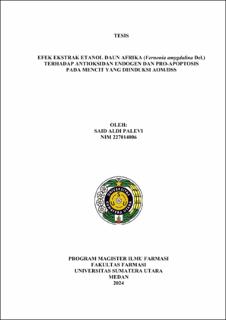| dc.description.abstract | Colon cancer is the third most commonly diagnosed cancer and the second
leading cause of death in the world after lung cancer. In Indonesia, colon cancer ranks
third. Colon cancer is a tumor that originates from the colon tissue to the colon. High
fat consumption, low fiber consumption and exposure to free radicals are some of the
risk factors for colon cancer. Protective effects can be obtained by consuming
antioxidants found in vegetables and fruits. African leaves (Vernonia amygdalina
Delile.) contain high antioxidants and have many pharmacological effects, one of
which is as an anti-inflammatory and anticancer. African leaves have been studied to
have anticancer activity through in vitro and in vivo tests including; nasopharyngeal
cancer, skin cancer cells, prostate cancer cells, breast cancer cells, pancreatic cancer
cells and liver cancer cells.
This study aims to analyze the effect of African leaf ethanol extract (Vernonia
Amygdalina Del.) on endogenous antioxidants and pro-apoptosis in mice induced by
AOM/DSS. To test the effectiveness of colon cancer anticancer of African leaf
ethanol extract in colon cancer model mice, histopathological examination of colon
cancer was carried out using HE staining and parameters were analyzed, namely
SOD, MDA, Caspase-3 and Bcl-2 levels. This research stage includes the preparation
of African leaf ethanol extract, phytochemical screening, extract standardization and
testing the effectiveness of African leaves on colon cancer damage. Data were
analyzed using one-way ANOVA with p<0.05:
Histopathological description of the colon with HE staining showed that
AOM/DSS can provide a response to the development of cancer cells in the colon of
mice such as malignant conditions accompanied by an inflammatory response.
EEDA 100 mg/kgBW can increase SOD levels which are significantly different
(p≤0.05) from the negative control group, but not more optimal than EEDA 500
mg/kgBW. EEDA 100 mg/kgBW and 300 mg/kgBW can reduce MDA levels which
are significantly different (p≤0.05) against the negative control group, but not more
optimal than EEDA 500 mg/kgBW. EEDA 300 mg/kgBW can increase caspase-3
levels which are significantly different (p≤0.05) against the negative control group
but not more optimal than EEDA 500 mg/kgBW. EEDA 100 mg/kgBW can reduce
Bcl-2 levels which are significantly different (p≤0.05) against the normal group, but
not better than EEDA 300 mg/kgBW and 500 mg/kgBW.
The results showed that EEDA has effects on endogenous antioxidants and
pro-apoptosis in mice induced by AOM/DSS. | en_US |


